Top 10 Benefits of Remote Patient Monitoring
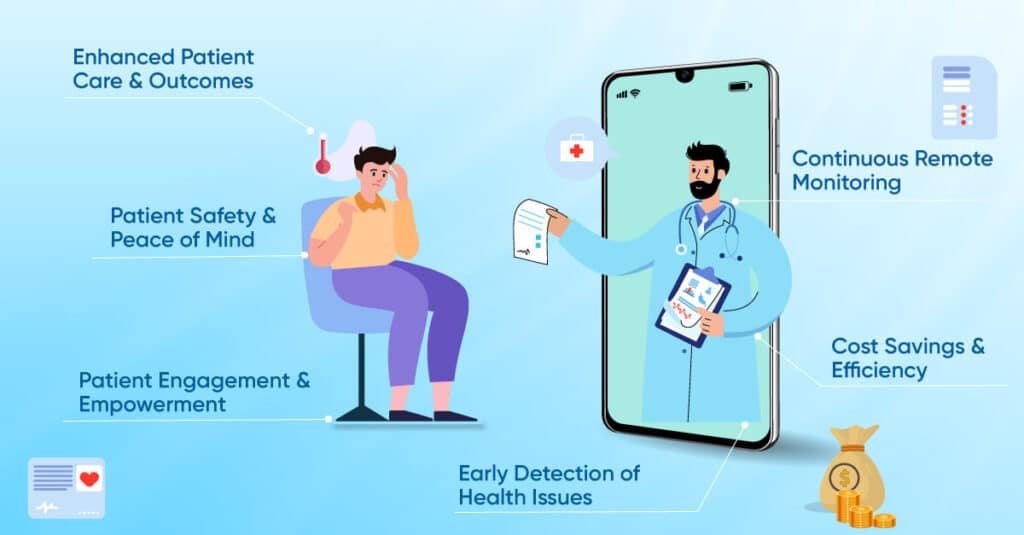
Remote patient monitoring (RPM) uses technology to collect patient data outside traditional healthcare settings. This approach benefits patients, clinicians, caregivers, and the healthcare system.
There are several benefits of remote patient monitoring to consider. These include increased access to virtual healthcare, more ways to communicate with healthcare providers, and improved patient involvement in self-care. Additionally, it helps reduce the spread of COVID-19 and lowers the overall cost of healthcare.
Let’s look at ‘What are the benefits of remote patient monitoring in detail:
1. Enhanced Patient Care and Outcomes
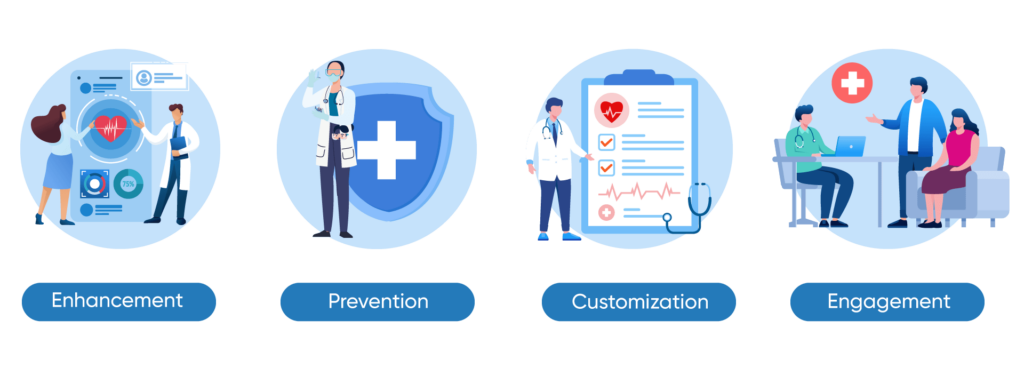
Improved monitoring and management of chronic conditions
Remote patient monitoring benefits, especially for people with chronic illnesses like diabetes, heart disease, or hypertension. Monitoring vital signs helps healthcare providers manage chronic illness. It also helps improve the quality of life. This is done by tracking blood pressure, blood glucose levels, and more.
Timely detection of health issues and early intervention
In short, remote monitoring in healthcare helps professionals quickly identify changes or worsening symptoms by continuously monitoring patients’ health information. Also, early identification enables quick intervention and therapy modifications, lowering the risk of complications and increasing patient outcomes.
Personalized care plans based on real-time data
Remote patient monitoring (RPM) not only helps doctors create personalized treatment plans using real-time patient data but also leads to better therapies and helps patients follow treatment strategies more effectively.
Better patient engagement and empowerment in their health
RPM empowers patients since they have access to their health data and progress. Being involved makes patients feel responsible and motivated to manage their health, leading to better health results.
2. Continuous Remote Monitoring
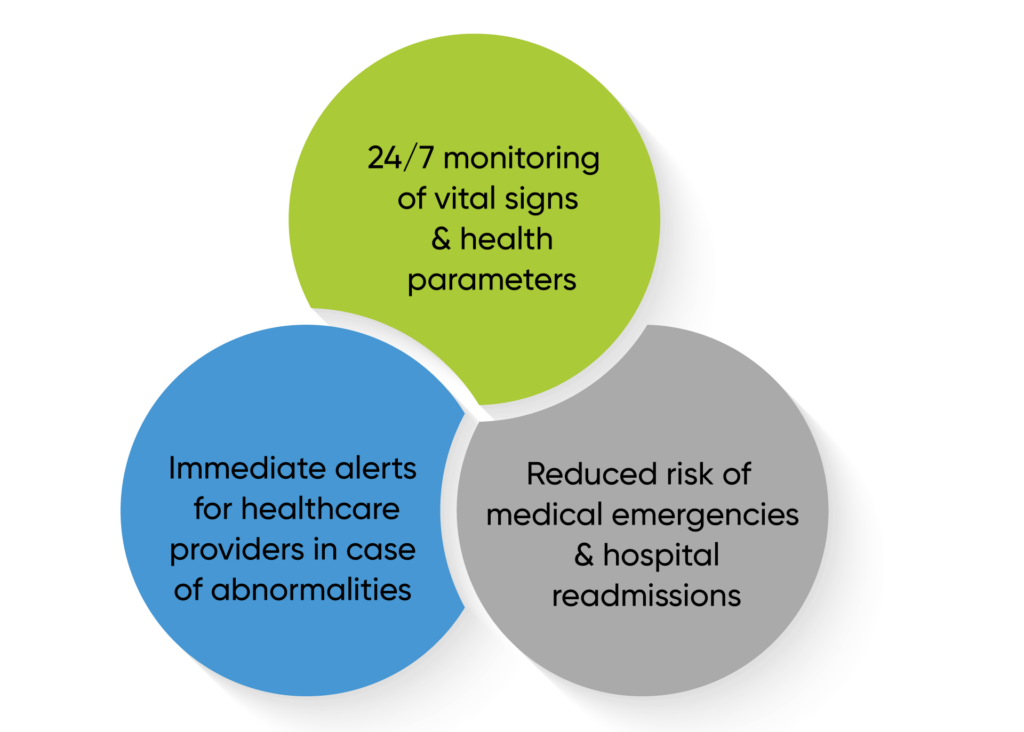
24/7 monitoring of vital signs and health parameters
Continuous Remote Monitoring allows healthcare practitioners to obtain real-time patient data and monitor their health state continuously. Moreover, quick access to data enables early detection of changes, leading to faster interventions and improved patient results.
Real-time data transmission and analysis
Continuous monitoring gathers lots of data, helping healthcare professionals to analyze long-term patient health patterns. Then this long-term view of patient information helps find patterns, predict issues, and make data-based decisions for better treatment outcomes.
Immediate alerts for healthcare providers in case of abnormalities
Healthcare providers may use Continuous monitoring to set up alerts and notifications for critical values or worrying patterns. The system can alert the healthcare team when health measurements exceed set limits. This then prompts them to take action, even outside of office hours.
Reduced risk of medical emergencies and hospital readmissions
CRM becomes crucial for remotely monitoring and treating patients during urgent scenarios like COVID-19 outbreaks or natural catastrophes. It straightaway reduces the need for touching. Therefore this lowers the risk of spreading infections. It also ensures ongoing care for patients in challenging situations.
3. Improved Access to Healthcare
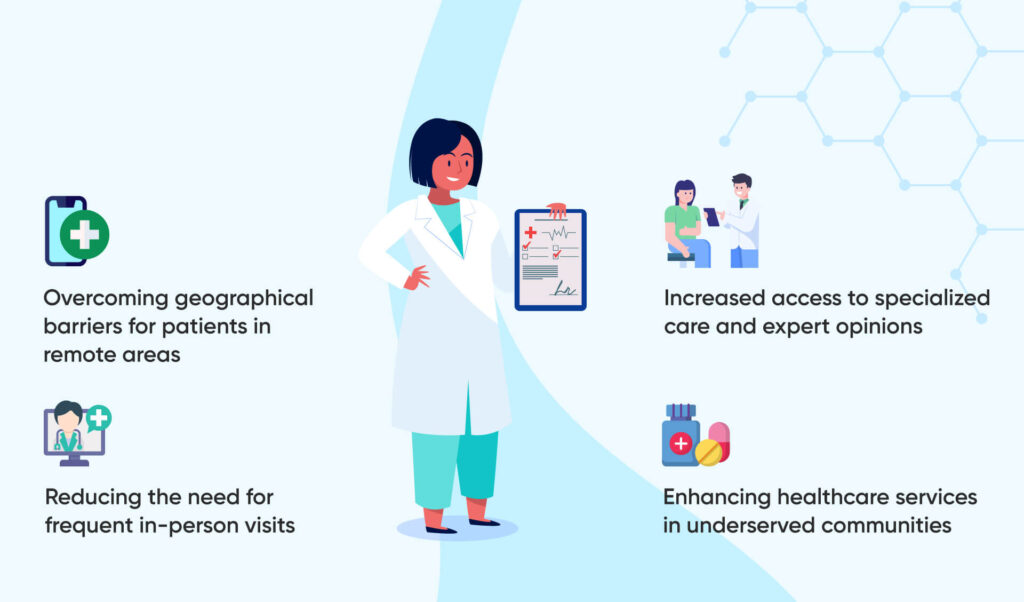
Overcoming geographical barriers for patients in remote areas
Remote Patient Monitoring cuts reduce geographical boundaries, making it easier for people in remote or rural places to obtain healthcare services. They can be treated and monitored without traveling considerable distances to a healthcare institution.
Increased access to specialized care and expert opinions
Remote patient monitoring benefits doctors. It allows primary care physicians and specialists to work together. They can share data for analysis and gain valuable insights. It also allows patients to access second views from specialists in their respective disciplines, enabling them to make informed healthcare decisions.
Reducing the need for frequent in-person visits
There are multiple advantages of remote patient monitoring in healthcare for people with mobility issues or those living far from medical centers. This reduces the burden of travel, especially for the elderly or weakened, making it easier for them to get treatment.
Enhancing healthcare services in underserved communities
RPM assists less fortunate people, such as older people, who may have difficulty receiving healthcare. It guarantees that healthcare is delivered directly to their homes, ensuring they receive medical treatment.
4. Cost Savings and Efficiency
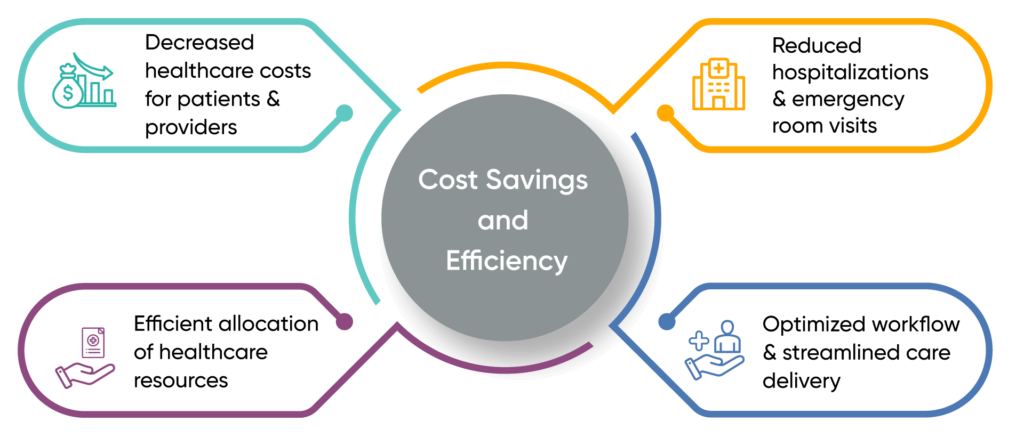
Decreased healthcare costs for patients and providers
RPM can contribute to long-term cost savings in healthcare by improving patient outcomes and reducing problems. Effective chronic disease care can lessen the need for costly treatments and hospitalizations over time.
Reduced hospitalizations and emergency room visits
One of the benefits of remote patient monitoring is that it enables healthcare practitioners to monitor patients’ status remotely, enabling early detection of difficulties and consequences. This proactive approach minimizes hospital readmissions and saves patients and healthcare systems money. Remote patient monitoring reduces in-person visits, saving time and effort for patients. Finding health problems early saves money by avoiding costly emergency care and making regular medical appointments more affordable.
Efficient allocation of healthcare resources
During health crises like pandemics, remote patient monitoring benefits in managing patient care from a distance. It can also help reduce the burden on hospitals and prioritize resources for those most need them.
Optimized workflow and streamlined care delivery
RPM systems frequently have integrated platforms for organizing and displaying patient data in a user-friendly way. This optimized workflow enables healthcare practitioners to obtain essential information swiftly, make educated decisions, and connect with patients.
5. Early Detection of Health Issues
Prompt identification of deteriorating health conditions
Remote patient monitoring benefits doctors to detect small health changes that could indicate a problem or worsen an existing illness. This early detection enables prompt response before the situation worsens. Alarm mechanisms alert practitioners to anomalous readings or significant health occurrences requiring immediate attention for prompt medical intervention.
Timely intervention to prevent complications
Remote patient monitoring benefits doctors in identifying risk factors or early signs of health issues before they become significant problems. This proactive strategy enables the implementation of preventative care measures, lowering the chance of severe consequences.
Proactive management of chronic diseases
RPM benefits chronic illnesses like diabetes, heart disease, or hypertension. Monitoring health markers helps identify trends indicating the need for treatment adjustments or lifestyle changes.
Monitoring medication adherence and treatment effectiveness
Remote patient monitoring allows healthcare professionals to track patient medication plans and ensure they take them correctly, improving treatment outcomes.
6. Remote Chronic Disease Management
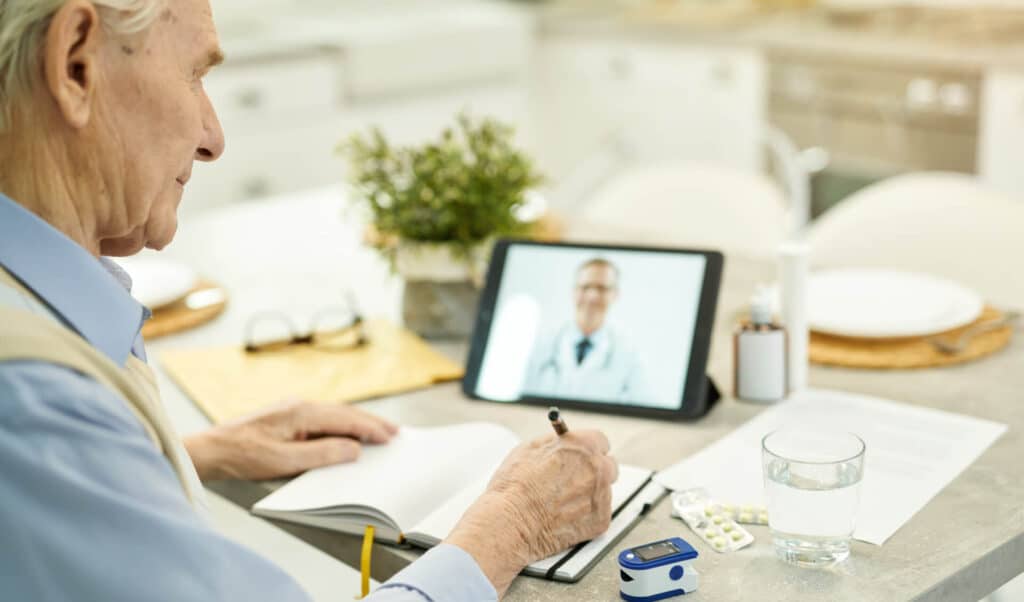
Effective management of chronic conditions from home
Benefits of rpm, especially for chronic illnesses, including diabetes, heart disease, or hypertension. Monitoring health markers helps identify trends indicating the need for treatment adjustments or lifestyle changes.
Empowering patients to self-monitor and self-manage
RPM places the patient at the heart of their treatment. Patients involved in decision-making and accessing their health data empower and improve their health outcomes.
Minimizing disease progression and related complications
Practical RPM benefits prevent illness worsening, reduce hospitalizations, and minimize emergency department visits through early intervention. This not only improves patient well-being but also lowers healthcare expenditures.
Facilitating remote consultations and telemedicine
The benefits of RPM are often used with telemedicine and virtual consultations, letting patients talk to healthcare providers without going in person. This comfort and accessibility may inspire individuals to communicate with their healthcare team more frequently.
7. Patient Safety and Peace of Mind
Increased patient safety through continuous monitoring
RPM allows for continuous monitoring of patients’ health problems even while they are not in standard healthcare settings. Continuous supervision finds problems quickly, leading to faster responses and proper care for patient safety.
Peace of mind for patients and their caregivers
Rpm benefits patients’ and caregivers’ peace of mind by providing real-time access to health data. Patients are aware that their conditions are being monitored. Caregivers feel more confident in managing the health of their loved ones with the assistance of healthcare experts.
Prompt response to critical health situations
Early recognition of deteriorating symptoms can motivate quick intervention, improving disease containment and dissemination control.
Ensuring a sense of security and confidence in healthcare
Rpm benefits ensure secure, confident healthcare with personalized, proactive, and continuous care. Using technology to monitor patients from a distance, RPM improves patient well-being and builds trust between patients and healthcare providers.
8. Data-Driven Healthcare Decisions
Access to comprehensive patient health data
RPM continually collects data, delivering real-time information on a patient’s vital signs, symptoms, and other health parameters. This real-time data enables healthcare practitioners to make educated decisions regarding a patient’s treatment.
Analyzing trends and patterns for better decision-making
The use of RPM data provides for a more proactive approach to healthcare. Patterns and trends in patient data can be identified by providers, indicating an increased risk of specific health issues. They can offer preventative actions and health promotion programs to lower risks and enhance overall health.
Identifying population health trends and insights
RPM data can be combined and analyzed to find patterns in large healthcare systems that care for many patients. This data can help allocate resources, identify problem areas, and create customized treatments for different groups of people.
Supporting evidence-based medicine and personalized care
The wealth of data collected through RPM enables healthcare providers to tailor care plans to individual patients’ needs. Providers can offer personalized treatment strategies by analyzing patient data, leading to more effective and efficient care.
9. Improved Medication Management
Monitoring medication adherence and compliance
RPM enables healthcare practitioners to monitor whether patients take their prescriptions as directed. Patients can be reminded to take their prescriptions through connected devices or smartphone applications, enhancing adherence rates. Non-adherence can be detected early, and actions to address the problem can be adopted.
Reminders and alerts for medication schedules
RPM makes creating individualized medication regimens for each patient easier based on their unique needs. This method considers dose timings, drug interactions, and patient preferences. It helps patients follow their treatment plans more easily.
Optimizing medication plans based on patient response
Remote Patient Monitoring has various benefits that lead to better drug management. This technology assists individuals in managing their medication. It provides up-to-date information about drugs. It also generates customized treatment plans. Additionally, it allows for remote adjustments. Furthermore, it enhances communication between patients and healthcare professionals. As a result, RPM can improve health outcomes and overall patient satisfaction.
10. Patient Engagement and Empowerment
Active involvement of patients in their care
Patients who use RPM are actively involved in their health monitoring. They collaborate with their healthcare professionals to make treatment regimens, lifestyle adjustments, and overall wellness decisions.
Access to personal health data and insights
RPM gives patients real-time access to their health data via user-friendly platforms or mobile apps. Patients become more educated and engaged in their health management by observing their vital signs, symptoms, and progress.
Education and self-management tools for patients
RPM platforms frequently offer educational materials and information about various health concerns. Patients can learn about their diseases, treatment options, and self-care techniques, promoting health literacy and empowerment.
Promoting a sense of ownership and accountability for health
RPM allows patients to maintain their health from home, reducing hospital visits and promoting self-sufficiency and empowerment. Feedback and progress tracking help patients see how their health improves, motivating them to make healthier choices.
Conclusion
The benefits of remote patient monitoring for doctors and patients are creating a revolution in the healthcare industry. It allows for better patient engagement and remote monitoring of their health. RPM reduces setup costs and resource requirements for healthcare practices, as it helps decrease emergency visits and hospital readmission rates.
Frequently Asked Questions
Rpm benefits enable patients to provide real-time health data, encourage active involvement, and promote personalized care plans. This improves the relationship between patients and providers. It also helps patients follow treatment.
Additionally, it gives patients more control over their health. As a result, it leads to better health and satisfaction. RPM improves chronic disease management, reduces hospitalizations and costs, and offers increased efficiency and convenience through remote access to healthcare services. It helps patients take control of their health, leading to better health and satisfaction with their care.
Modern patient monitoring systems utilize advanced technology and real-time data collection to enhance patient safety, clinical results, and healthcare delivery. They enable continuous monitoring of vital signs, early diagnosis of irregularities, and prompt intervention.
Remote care helps patients stay home and feel better and lets healthcare workers watch more patients simultaneously. These systems assist in making improved decisions, planning treatments, involving patients more, and enhancing patient experiences. They also help in reducing costs and improving healthcare quality.
RPM has multiple uses in healthcare. It can help manage chronic diseases and aid in post-surgery recovery. RPM is also beneficial for caring for the elderly and providing mental health support.
Additionally, it can be used for monitoring infectious diseases and managing complex medical conditions. Lastly, RPM provides ongoing care in rural or underserved areas. It captures patient data in real-time, increasing patient participation, allowing faster interventions, and enhancing overall health results.




